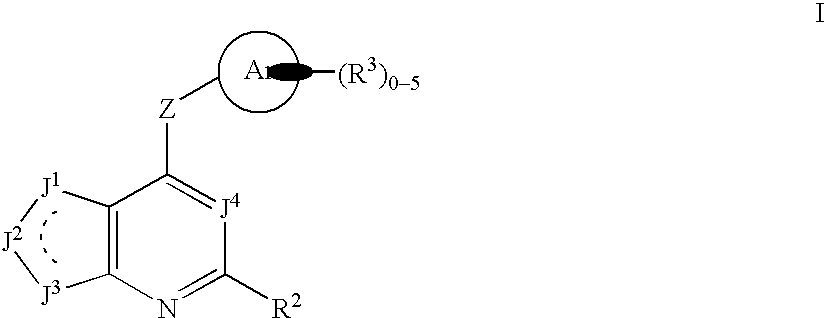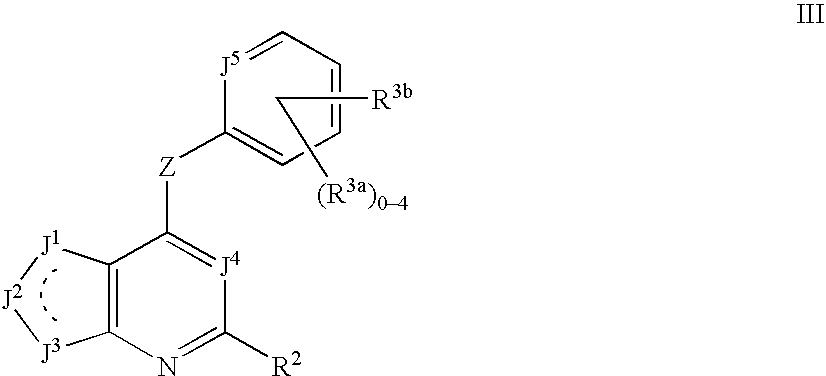c-MET MODULATORS AND METHOD OF USE
- Summary
- Abstract
- Description
- Claims
- Application Information
AI Technical Summary
Benefits of technology
Problems solved by technology
Method used
Image
Examples
example 1
[0202]
[0203] 1-(4-Fluoro-phenylcarbamoyl)-cyclopropanecarboxylic acid. The title compound was prepared based on a modified procedure of Shih and Rankin [Synthetic Communications, 1996, 26(4), 833-836]: To a mixture of cyclopropane-1,1-dicarboxylic acid (21.2 g, 0.163 mol, 1.0 eq.) in anhydrous THF (200 mL) under nitrogen was added dropwise triethylamine (16.49 g, 0.163 mol, 1.0 eq.) with stirring for 30 minutes at 0° C., followed by the addition of thionyl chloride (19.39 g, 0.163 mol, 1.0 eq.) with stirring for another 30 minutes at 0° C. To the resulting mixture under nitrogen was added dropwise a solution of 4-fluoroaniline (19.92 g, 0.179 mol, 1.1 eq.) in anhydrous THF (100 mL) with stirring for 1:5 hours at 0° C. The reaction mixture was diluted with ethyl acetate and washed with 1N NaOH. The layers were separated, and the ethyl acetate layer was concentrated in vacuo to give a brownish solid. The brownish solid was washed with small amount of cold ethyl acetate, filtered and d...
example 2
[0204]
[0205] 1-Benzylcarbamoyl-cyclopropanecarboxylic acid. The title compound was prepared based on a modified procedure of Shih and Rankin [Synthetic Communications, 1996, 26(4), 833-836]: To a mixture of cyclopropane-1,1-dicarboxylic acid (5.0 g, 38.4 mmol, 1.0 eq.) in anhydrous THF (50 mL) under nitrogen was added dropwise triethylamine (3.89 g, 38.4 mmol, 1.0 eq.) with stirring for 30 minutes at 0° C., followed by the addition of thionyl chloride (4.57 g, 38.4 mmol, 1.0 eq.) with stirring for another 30 minutes at 0° C. To the resulting mixture under nitrogen was added dropwise a solution of benzylamine 5 (4.53 g, 42.3 mmol, 1.1 eq.) in anhydrous THF (25 mL) with stirring for 1.5 hours at 0° C. The reaction mixture was diluted with ethyl acetate and extracted with 2N NaOH (to pH 10). The aqueous phase was titrated with 2N HCl to pH 1-2 and then extracted with ethyl acetate. The organic phase was dried with sodium sulfate and concentrated in vacuo to give 1-Benzylcarbamoyl-cyclo...
example 3
[0206]
[0207] 1-Phenylcarbamoyl-cyclopropanecarboxylic acid. To a mixture of cyclopropane-1,1-dicarboxylic acid (5.29 g, 40.7 mmol, 1.0 eq.) in anhydrous THF (50 mL) under nitrogen was added dropwise triethylamine (4.12 g, 40.7 mmol, 1.0 eq.) with stirring for 30 minutes at 0° C., followed by the addition of thionyl chloride (4.84 g, 40.7 mmol, 1.0 eq.) with stirring for another 30 minutes at 0° C. To the resulting mixture under nitrogen was added dropwise a solution of phenylamine 9 (4.17 g, 44.8 mmol, 1.1 eq.) in anhydrous THF (25 mL) with stirring for 1.5 hours at 0° C. The reaction mixture was diluted with ethyl acetate and extracted with 2N NaOH (to pH>10). The aqueous phase was titrated with 2N HCl to pH 1-2 and then extracted with ethyl acetate. The organic phase was dried with sodium sulfate and concentrated in vacuo to give 1-phenylcarbamoyl-cyclopropanecarboxylic acid as a white solid (5.08 g, 60.8%). 1H NMR (400 MHz, CDCl3): 10.50 (br s, 1H), 7.56-7.54 (m, 2H), 7.35-7.31 (...
PUM
| Property | Measurement | Unit |
|---|---|---|
| Fraction | aaaaa | aaaaa |
| Volume | aaaaa | aaaaa |
| Fraction | aaaaa | aaaaa |
Abstract
Description
Claims
Application Information
 Login to View More
Login to View More - R&D
- Intellectual Property
- Life Sciences
- Materials
- Tech Scout
- Unparalleled Data Quality
- Higher Quality Content
- 60% Fewer Hallucinations
Browse by: Latest US Patents, China's latest patents, Technical Efficacy Thesaurus, Application Domain, Technology Topic, Popular Technical Reports.
© 2025 PatSnap. All rights reserved.Legal|Privacy policy|Modern Slavery Act Transparency Statement|Sitemap|About US| Contact US: help@patsnap.com



